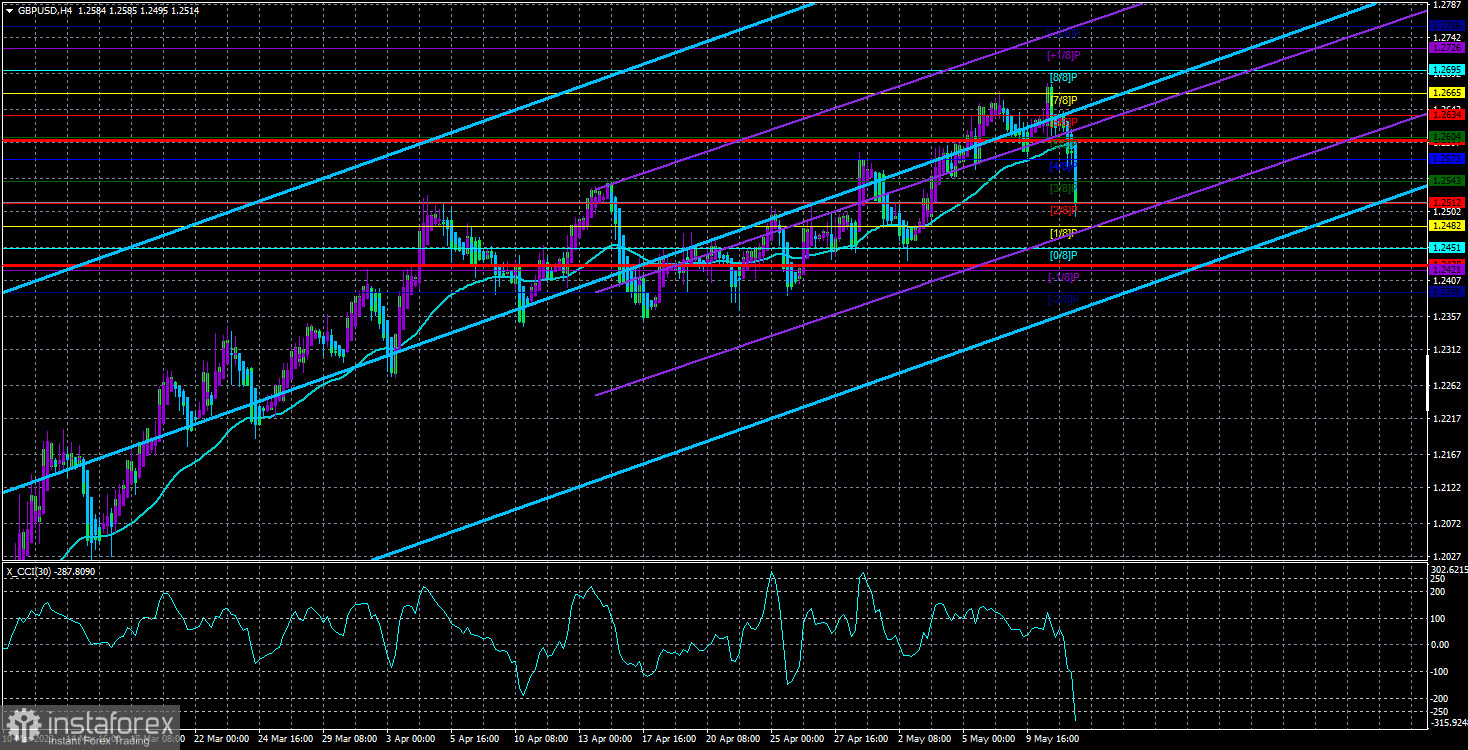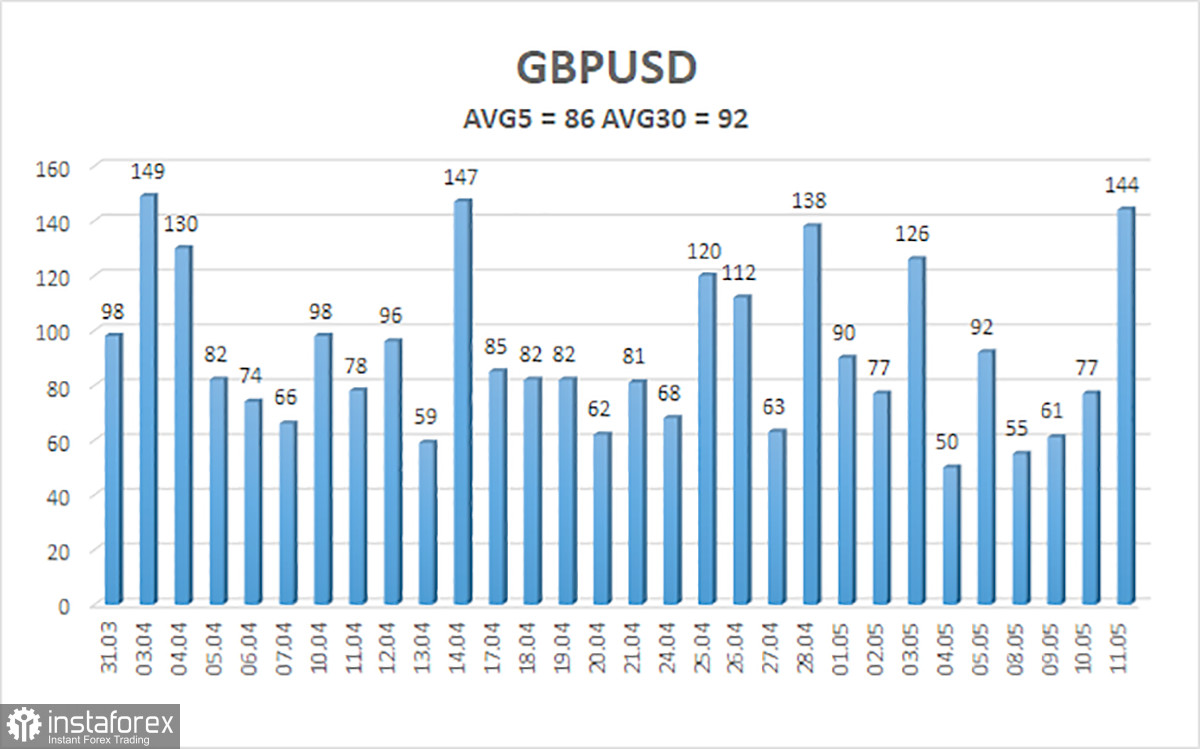
The GBP/USD currency pair finally began to fall on Thursday. It had been rising for over two months straight without correcting itself. While the growth may not have been the strongest in recent days and weeks, it was still stable. However, Chairman Andrew Bailey gave a speech after announcing the Bank of England meeting's results yesterday. Initially, the market barely reacted to the regulator's decisions, but about an hour later, the British pound plummeted. We'll discuss Bailey's statements a bit later, but for now, let's say that the rate increased by another 0.25%, as predicted, and the number of voting members of the monetary committee "for" raising the rate was 7, as predicted. Therefore, the market had nothing to react to, and its decision was preemptively taken, which often happens before important, predictable events.
As a result, the pair consolidated below the moving average line and immediately showed good downward movement. We still expect a strong fall in the British currency, as the Bank of England is in the final stages of a monetary policy tightening cycle. No matter what inflation is in the UK, the rate cannot grow constantly, as fears of a recession would become a reality. The regulator would not want to provoke a banking and economic crisis in its country, especially after recent strikes demanding wage increases. Therefore, at this time, the rate will rise one more time, or at most, twice by 0.25%. 5% is already a high value recommended to be maintained for a short time.
If so, the pound has no advantage over the dollar anymore. Previously, traders could buy the pair based on the logical expectation of a stronger rate hike by the BoE in 2023. But this factor is already negated. Mr. Bailey made it clear that the regulator will now raise the rate on a case-by-case basis and will keep a close eye on the state of the economy.
Inflation will start to fall, but this is uncertain.
The first thing Andrew Bailey reported was inflation. He noted that inflation shows more resilience than expected but will inevitably begin to decline starting in April. The Chairman of the Bank of England stated that he understands the problems of poor Britons, for whom the monthly rise in food prices is becoming a serious problem. Still, he promised the regulator would do everything possible to achieve price stability. "We see signs of a slowdown in food inflation, and by the end of the year, it should halve," Bailey believes. Recall that the Bank of England previously forecasted 2.9% inflation by the end of the year, which looked fantastic.
Mr. Bailey also noted that the unemployment rate and prospects for economic growth are improving. The British economy has coped "excellently" with all shocks. The key rate will be adjusted as needed, with careful analysis of the incoming data. "As needed" may mean that a pause may be taken at the next meeting. If the Bank of England expects inflation to fall in April, then it would be logical to wait a few months before the next increase to see how quickly it falls. If the decline is as forecasted, why continue tightening if inflation will slow down even without it?
Thus, Bailey's speech can be considered "moderately dovish." In conjunction with the absence of growth factors for the British pound, the pound could not help but fall after the meeting. Unfortunately, the CCI indicator has already entered the oversold area, considered a strong buy signal. However, the pound has fallen just over 200 points so far, so this signal can hardly be considered strong. We expect a further decline, as we said earlier. Targets are scattered up to the level of 1.1840, which served as the lower boundary of the sideways channel for a long time on the 24-hour timeframe. The intermediate target is the Senkou Span B line on the daily TF - 1.2162.

The average GBP/USD pair volatility over the last five trading days has been 86 points. For the pound/dollar pair, this value is "medium." As a result, we anticipate movement within the channel on Friday, May 12, with the levels of 1.2428 and 1.2600 serving as limits. A reversal of the Heiken Ashi indicator upwards will signal a possible resumption of the upward movement.
Nearest support levels:
S1 - 1.2512
S2 - 1.2482
S3 - 1.2451
Nearest resistance levels:
R1 - 1.2543
R2 - 1.2573
R3 - 1.2604
Trading recommendations:
The GBP/USD pair on the 4-hour timeframe has consolidated below the moving average and has real chances to continue falling. Therefore, you can stay in short positions with targets of 1.2451 and 1.2428 until the Heiken Ashi indicator turns upwards. Long positions can be considered when the price consolidates back above the moving average with the first targets of 1.2665 and 1.2695.
Illustration explanations:
Linear regression channels - help to determine the current trend. If both are directed in one direction, the trend is strong.
Moving average line (settings 20.0, smoothed) - determines the short-term trend and the direction to trade now.
Murray levels - target levels for movements and corrections.
Volatility levels (red lines) - the likely price channel the pair will spend the next day, based on current volatility indicators.
CCI indicator - its entry into the oversold area (below -250) or the overbought area (above +250) means that a trend reversal is approaching in the opposite direction.
 English
English 
 Русский
Русский Bahasa Indonesia
Bahasa Indonesia Bahasa Malay
Bahasa Malay ไทย
ไทย Español
Español Deutsch
Deutsch Български
Български Français
Français Tiếng Việt
Tiếng Việt 中文
中文 বাংলা
বাংলা हिन्दी
हिन्दी Čeština
Čeština Українська
Українська Română
Română

